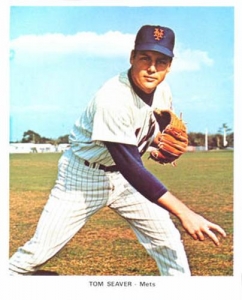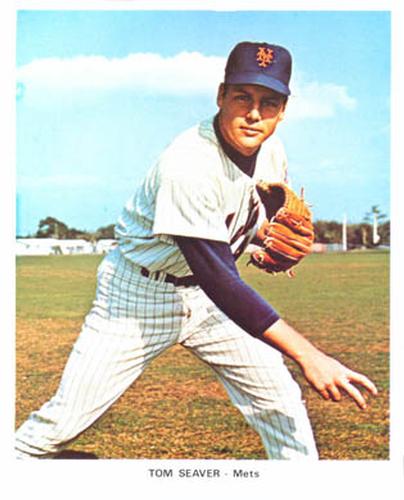May 15, 1970: Tom Seaver pitches his second career one-hitter for Mets
 The New York Mets arrived in Philadelphia after a brief stop in Chicago where the teams could play only one game because of the weather. Gary Gentry pitched spectacularly in that May 13 game, throwing the fifth one-hitter in the team’s short history. The win left the Mets 1½ games behind the division-leading Chicago Cubs. After a day off, New York sent its ace, Tom Seaver, to the mound for the first game of a pair against the fifth-place Phillies.
The New York Mets arrived in Philadelphia after a brief stop in Chicago where the teams could play only one game because of the weather. Gary Gentry pitched spectacularly in that May 13 game, throwing the fifth one-hitter in the team’s short history. The win left the Mets 1½ games behind the division-leading Chicago Cubs. After a day off, New York sent its ace, Tom Seaver, to the mound for the first game of a pair against the fifth-place Phillies.
Gentry’s performance had helped the Mets reach .500 for the season – the 12th time so far in 1970 that the inconsistent Mets had ended a day even in wins and losses. After the game, Mets manager Gil Hodges said he would return to the platoon system that had been successful the previous year when the team won its first World Series championship. Previously he had tried to “hit upon a regular lineup, one that included Art Shamsky and Ken Boswell. Both are south swingers and both faced southpaw pitching the last time.”1
But when that lineup failed to produce any runs in a 3-0 loss to Montreal on May 11, Hodges told reporters before the first game in Philadelphia, “We’ll use our right-handed lineup tomorrow” after hearing that the team would face a lefty. As Dick Young of the New York Daily News wrote, “Hodges had seen enough.”2
The Phillies entered the series with the Mets on a seven-game losing streak. In an attempt to turn things around, Philadelphia recalled 20-year-old Oscar Gamble from the Eugene Emeralds, its Pacific Coast League farm club. Gamble, who had come to Philadelphia in a November 1969 deal that sent Johnny Callison to the Cubs, would be inserted into center field. Another young outfielder, Larry Hisle, who the Phillies had originally planned would take over center, would instead move to right in hopes of getting him out of a slump.
Phillies manager Frank Lucchesi said, “We’ve got nothing to lose, that’s my theory on this. It might take a little pressure off Hisle. Gamble’s hungry and it’s made him an aggressive kid. That’s what we need around here, a little more aggressiveness.”3
Lucchesi sent Woody Fryman to the mound for the evening start. Fryman had won two games in April but none in his last three starts. He saw his ERA jump from 2.45 to 4.09 during that time.
Fryman retired the side in order in the first, but things did not go as smoothly for him in the second, when two Mets reached base on errors. Ron Swoboda hit a grounder to third and was safe when first baseman Deron Johnson couldn’t handle the throw from Don Money. Joe Foy then reached first when Gamble couldn’t handle his fly ball.
Swoboda thought Gamble caught the ball and started to trot back to first. Foy, who had seen Gamble drop the ball, continued to run. “In a bit of horseplay right out of Mets history, Swoboda kept running [back to first] and passed Foy, who was ruled out.”4 (Foy was called out when he passed Swoboda on the bases.)
Lucchesi argued that both runners should be out because the ball came into second to force out Swoboda. But the umpire said the runners had already crossed paths before the ball arrived, so there was no force situation.
With two outs, Jerry Grote singled to put runners at the corners. But Fryman got Al Weis to fly out to center. This time Gamble caught the ball to keep the Mets from scoring.
Seaver started out strong, perhaps due to the extra day of rest he got because of the weather postponing the Mets’ second game in Chicago. He struck out four batters in the first two innings. The Phils got a runner on base in the first when John Briggs reached on second baseman Weis’s error. But he was caught stealing one pitch later to end the frame.
With one out in the third, Seaver faced Mike Compton. The rookie catcher had been called up two weeks earlier when both Phillies catchers went down with injuries. With the count 2-and-2, Compton swung at Seaver’s fastball. He made contact and lined the ball to right field for a single.
Seaver was not pleased with his pitch, saying afterward, “I was trying to hit the corner. I got the pitch up a little and I thought it was down the middle. He might have been stepping away from it a little.” Compton said he thought the pitch was on the outside.5 Compton reached second when third baseman Foy threw wild to first on Gamble’s grounder, Seaver struck out two more batters to end the scoring threat. This time there was no drama about a no-hitter – unlike the previous season, when the Cubs’ Jim Qualls broke up Seaver’s no-hit bid in the top of the ninth.
The Mets scored in the fourth. Donn Clendenon led off with a single and Swoboda followed with a double. Fryman’s first pitch to Foy was wild, and Clendenon dashed for home. “[Compton] getting a strong rebound from the backstop, fired home – but Fryman failed to cover. Swoboda thus scored in back of Clendenon on the play.”6
Those runs would be all Seaver needed, although the Mets had another chance as Fryman continued to struggle in the frame. He walked Foy and gave up a two-out single to Seaver. Both runners advanced when Gamble’s throw to third was off the mark. But Fryman got Tommie Agee to foul out to the catcher, ending the inning.
Lucchesi, when asked about Gamble’s errors, said, “I thought he was the most nervous kid in the park. And furthermore, he’ll be right back in there against Koosman tomorrow night.7
After walking Briggs in the fourth, Seaver struck out two more Phillies to bring his total to eight. He would end up striking out at least one batter in every inning of the contest.
Fryman retired the first batter in the fifth but then walked Cleon Jones and Clendenon. He struck out Swoboda and it appeared he might get out of the jam. But Foy singled, scoring Jones and sending Clendenon to third.
Lucchesi brought in reliever Bill Wilson. The right-hander got two strikes on Grote before the Mets catcher singled to left. Clendenon scored. Foy was thrown out as he tried to reach third on the play to end the Mets rally. The Mets now led 4-0
Seaver walked two more batters, the only Phillies to reach base down the stretch. He walked Briggs in the sixth. His 11th strikeout, of Money, left Briggs stranded. Compton walked to lead off the eighth but again it came to naught as Seaver struck out two of the next three batters, leaving the Phillies looking helpless against him.
Needing just three more outs to get his seventh win of the season, Seaver retired the Phillies in order in the ninth. The final out came when Johnson went down swinging, Seaver’s 15th strikeout of the game.
Seaver, who was drinking some tea after the game to fight a cold that had bothered him since his 19-strikeout performance on April 19, was asked if the extra day of rest helped. “It’s a mixture of the two, actually,” he said. “The way the schedule works out, sometimes if you run into an open date you wind up pitching on the sixth day instead of the fifth day, so you’re better off working on the fourth day. It’s okay if the weather is cool. It doesn’t drain you the way hot weather does. But as far as doing it all the time, you’ll wear yourself out. You get into the last month and you’re dead tired.”8
The win brought the Mets to a half-game behind the Cubs, who lost to the Cardinals, 1-0. It also raised Seaver’s league-leading total of strikeouts to 88. It was Seaver’s sixth complete game of the season.
As for the Phillies, they now had failed to score on Seaver in 34 innings. But “Lucchesi was grinning from ear to ear when the reporters tiptoed into his office like guys attending a wake for a friend who died before his time. ‘What’s everybody so sad about?’ he said, later adding ‘It looks like we’re gonna have to have patience all year with this club.”9
Sources
In addition to the sources cited in the Notes, I used the Baseball-Reference.com and Retrosheet.org websites for box-score, player, team, and season pages, pitching and batting logs, and other pertinent material.
https://www.baseball-reference.com/boxes/PHI/PHI197005150.shtml
https://www.retrosheet.org/boxesetc/1970/B05150PHI1970.htm
Notes
1 Dick Young, “Hodges Restores Platoon to Keep Mets on Track,” New York Daily News, May 15, 1970: 94.
2 Young.
3 Bill Conlin, “Phils Take a Gamble in Center,” Philadelphia Daily News, May 15, 1970: 64.
4 Joseph Durso, “Seaver Hurls 1-Hitter, Fans 15,” New York Times, May 16, 1970: 33.
5 Bill Conlin, “Way Phillies Luck Running They’ll Catch Seaver’s Cold,” Philadelphia Daily News, May 16, 1970: 49.
6 Dick Young, “Seaver K’s 15 in 1-Hitter Repeat, 4-0,” New York Daily News, May 16, 1970: 32.
7 Conlin, “Way Phillies Luck.”
8 Conlin, “Way Phillies Luck.”
9 Conlin, “Way Phillies Luck.”
Additional Stats
New York Mets 4
Philadelphia Phillies 0
Connie Mack Stadium
Philadelphia, PA
Box Score + PBP:
Corrections? Additions?
If you can help us improve this game story, contact us.


